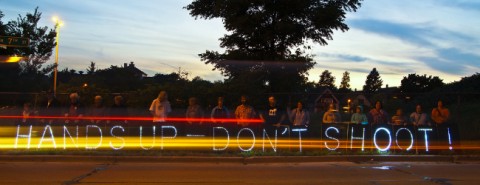Marching into danger: Fear and hope in Ferguson
I was walking with a group of clergy in Ferguson, Missouri, singing, “We Shall Overcome.” As we finished the verse that says, “We are not afraid today,” I turned to the person next to me and whispered, “That’s a lie. I am afraid.”
I knew that we would encounter the police at some point in the evening, but nothing prepared me for the sheer number of officers. We had gathered at dinnertime in the parking lot of a grocery store miles away from the protest site. By the time there were four of us, there were also four squad cars of officers telling us to leave.
We drove to the local high school, parked our cars, and began walking to the county prosecutor’s office in Clayton to present a letter with a list of demands, including an expedited grand jury process and the recusal of county prosecutor Bob McCulloch. Although we were far from the site of Michael Brown’s death, our route was guarded by scores of heavily armed officers. Squad cars drove slowly beside us, and there were SWAT teams and barricades.





